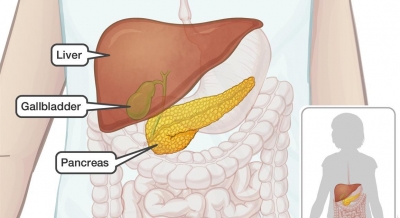
The pancreas and gallbladder play key roles in the next stage of food digestion, which takes place when food arrives in the small intestine from the stomach. Without them, the small intestine could not work properly.
The pancreas and gallbladder release different substances into the small intestine. The pancreas releases pancreatic juice, which is full of enzymes – chemicals that break food into smaller parts, so that they can be absorbed into the blood. It also produces hormones that control the amount of sugar in the blood. The gallbladder stores, processes, and releases bile, a liquid that helps the body to digest fat. During digestion of a meal, smooth muscles in the walls of the gallbladder contract to push bile into the bile ducts that lead to the duodenum. Once in the duodenum, bile helps with the digestion of fats.
The other 99% of the pancreas contains exocrine cells that produce powerful enzymes that are excreted into the duodenum during digestion. These enzymes together with water and sodium bicarbonate secreted from the pancreas are known as pancreatic juice.
Picture Credit : Google




